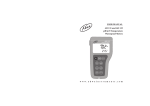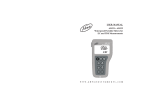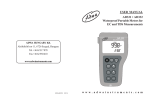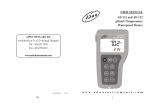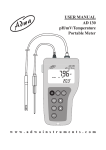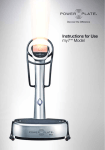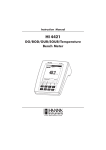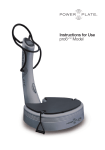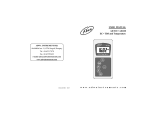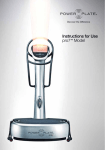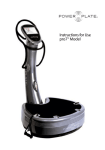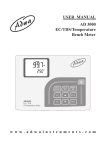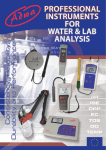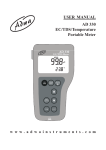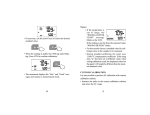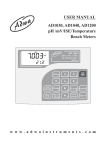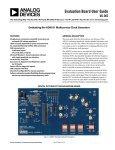Download USER MANUAL AD 630 DO & Temperature Waterproof Meter with
Transcript
USER MANUAL AD 630 DO & Temperature Waterproof Meter with Galvanic Probe w w w. a d w a i n s t r u m e n t s . c o m Dear Customer, Thank you for choosing an Adwa product. Please read carefully this manual before starting operations. This instrument is in compliance with the EMC Directive 89/336/EEC and Low Voltage Directive 73/23/EEC for electrical equipments. For more technical information, please e-mail us at [email protected]. WARRANTY Adwa warrants this product to be free of defects in material and workmanship as stated in the operating manual. If repair or adjustment is necessary and has not been the result of abuse, misuse or improper handling within the warranty period, please contact your dealer or the nearest Adwa Office for the RGA (Return Goods Authorization) number to put on the outside of your package. Warranted service will be made without charge. The meter is warranted for a period of 2 years, while probes are warranted for 6 months. The warranty period commences from the original date of sale. Warranty is only valid when the product is used under normal conditions and in accordance with the instruction manual. The warranty is void if the instrument is repaired or serviced by unauthorized personnel, not used in accordance to the instructions, or if non-Adwa accessories such as buffer solutions, probes, etc. are used in conjunction with the meter. Adwa will not be held responsible for any accident whether directly or indirectly, caused by the use of this instrument. 2 TABLE OF CONTENTS Introduction ................................................................ 4 Technical Data .......................................................... 6 Front and Top Panels ................................................ 8 Operational Guide .................................................... 10 DO Calibration ........................................................ 14 Temperature Adjustment ........................................ 19 Setup ........................................................................ 20 Good Laboratory Practice ....................................... 29 Log-on-demand ........................................................ 31 Hold function ........................................................... 35 PC Interface ............................................................ 36 Battery Replacement .............................................. 36 Probe and Membrane Maintenance ....................... 38 Probes, Solutions and Accessories ......................... 39 3 INTRODUCTION AD630 is a heavy-duty portable waterproof meter for DO (Dissolved Oxygen) and temperature measurements, designed to provide laboratory results and accuracy even under harsh industrial conditions. Main features include: • DO readings displayed in ppm or % saturation units • DO calibration at 1 or 2 standard points (0 and 100%), or at 1 custom point (>20%) • Galvanic DO probe with built-in temperature sensor • Automatic temperature compensation • Log-on-demand • Setup mode for setting altitude & salinity compensation factors, temperature measure unit (°C or °F), serial communication parameters, date & time, auto-off, instrument ID code • HOLD feature to freeze stable reading on the LCD • GLP feature to view last calibration data • PC interface via RS232 port This model is supplied complete with: • AD8001/3 galvanic DO probe with built-in temperature sensor, DIN connector and 3 m cable • Spare DO membrane with O-ring • Scouring pad for cleaning the probe • 1.5 V AA alkaline batteries (4 pcs) • User manual 4 5 TECHNICAL DATA Range 0.00 to 45.00 ppm O2 0.0 to 300.0 % saturation 0.0 to 50.0°C / 32.0 to 122.0°F Resolution 0.01 ppm / 0.1% 0.1°C / 0.1°F Accuracy ±1.5% f.s. (DO) ±0.5°C / ±1.0°F DO Calibration Automatic, at 1 or 2 standard points (0 and 100%) or 1 custom point (> 20%) Temperature Calibration User offset adjustment Temperature Compensation Automatic from 0 to 50°C Altitude Compensation 0 to 4000 m (resolution 100 m) Salinity Compensation 0.0 to 50.0 g/l (resolution 0.1 g/l) Log-on-demand Up to 100 samples PC Interface RS232 port 6 Probe (included) AD8001/3 galvanic DO probe with built-in temperature sensor, DIN connector and 3 m cable Environment 0 to 50°C (32 to 122°F) RH max. 100% non-condensing Power Supply 4 x 1.5 V AA, alkaline battery Battery Life Approx. 200 hours of continuous use Auto-off User selectable: 5 minutes or disabled Dimensions 188 x 96 x 70 mm Weight 460 g 7 FRONT AND TOP PANELS 8 1. ON/OFF key, to turn the instrument ON and OFF 2. HOLD/CLR key, to freeze stable reading on the LCD and clear logged data 3. CAL/SETUP key, to enter/exit calibration mode and enter/exit SETUP mode 4. CFM key, to confirm value 5. SHIFT key, to activate the key second function. Press first SHIFT and then the selected key. The SHIFT tag is displayed until the second key is pressed 6. DOWN arrow/MRCL key, to manually decrease the value of temperature or other parameters, and enter/exit the logged data viewing mode 7. UP arrow/STORE key, to manually increase the value of temperature or other parameters, and to store measured data 8. RANGE/GLP key, to select measurement range or switch focused data and display GLP information 9. Liquid Crystal Display (LCD) 10. RS232 connector 11. DIN connector for DO probe 9 OPERATIONAL GUIDE CONNECTIONS • The meter is supplied complete with four 1.5 V AA alkaline batteries. Remove the rear cover, unwrap the batteries and install them while paying attention to the correct polarity (see “Battery Replacement” section). • Connect the DO probe to the DIN socket on the top of the instrument. • The DO probe features a built-in temperature sensor for temperature measurement and compensation. PROBE PREPARATION The DO probe is shipped dry. To hydrate the probe and prepare it for use proceed as follows: • Remove the black & red plastic cap. This cap is used for shipping purposes only. • Insert the supplied O-ring in the membrane. bubbles remain trapped. To avoid damaging the membrane, do not touch it with your fingers. • With the sensor facing down screw the cap clockwise to the end of the threads. Some electrolyte will overflow. INSTRUMENT START-UP • Turn the instrument on by pressing the ON/OFF button. • At start-up the display shows all the used segments for a few seconds, then enters the measurement mode. • If the probe is disconnected, the meter will display only dashes “----”. • Rinse the supplied membrane with electrolyte while shaking it gently. Refill with clean electrolyte. Gently tap the membrane over a surface to ensure that no air 10 11 SALINITY AND ALTITUDE COMPENSATION If the sample contains significant concentration of salinity or if you are performing measurements at an altitude different from sea level, the read out values must be corrected, taking into account the lower degree of oxygen solubility in these situations (see “Setup” section for details). Remember to set the altitude and/or the salinity before taking any DO measurements. The meter will automatically compensate for these factors. DO MEASUREMENTS Make sure that the instrument has been calibrated and the protective cap has been removed. • Immerse the tip of the probe in the sample to be tested and allow for the reading to stabilize. • The DO value is displayed on the primary LCD and the temperature on the secondary LCD. • To select the desired unit (% or ppm), press RANGE. 12 For accurate DO measurements, a water movement of 0.3 m/s is required. This is to ensure that the oxygendepleted membrane surface is constantly replenished. A moving stream will provide adequate circulation. The use of a magnetic stirrer to ensure a certain fluid velocity is recommended. TEMPERATURE MEASUREMENTS The DO probe features a built-in temperature sensor, for temperature measurement and compensation. The temperature value is displayed on the secondary LCD level. Allow the probe to reach thermal equilibrium before taking any measurement. This can take several minutes. The greater the difference between the temperature at which the probe was stored and the temperature of the sample, the longer the time will be. Note: If the display shows only dashes “----”, the DO probe is not properly connected or the temperature is out of range. This can also indicate a broken probe cable. 13 DO CALIBRATION It is recommended to calibrate the instrument frequently, especially if high accuracy is required. Before proceeding with the calibration, make sure the probe is ready for measurements (see “Probe preparation” paragraph on page 10), i.e. the membrane cap is filled with electrolyte and the probe is connected to the meter and properly polarized. The instrument can be calibrated at 1 or 2 standard points, 0 and 100% (zero & slope), or at 1 custom point (>20%, slope calibration only). The zero calibration is very stable, and needs to be performed only when the probe or the membrane is replaced. The slope calibration is more critical, and it is recommended to perform the related procedure every week. STANDARD CALIBRATION Preparation • Pour small quantity of AD9070 zero oxygen solution into a beaker. • Make sure the probe is ready for measurements, i.e. the membrane is filled with electrolyte and the probe is connected to the meter. 14 • Switch the meter on by pressing the ON/OFF key. • Remove the probe protective cap. • Set the appropriate altitude factor and set the salinity factor to zero (see “Setup” section for details). Zero Calibration • Submerge the probe into AD9070 zero oxygen solution and stir gently for 2-3 minutes. • Press CAL. The CAL tag lights up and the hourglass symbol will blink on the LCD until the reading is stable. • When the reading is stable, CFM starts blinking. Press CFM to confirm the 0% calibration point. • To save a 1-point procedure, press CAL. The instrument will memorize the zero calibration data and return to measurement mode. For a 2-point calibration do not press CAL and follow the slope calibration procedure. Slope Calibration It is suggested to perform the slope calibration in air. • Rinse the probe in clean water to remove any residual zero oxygen solution. 15 Note: If you are performing a slope calibration only, press CAL and then use the ARROW keys to select the 100% DO calibration point. • Dry the probe tip and allow a few seconds for the reading to stabilize. The hourglass symbol will blink until the reading is stable. • When the reading is stable, CFM starts blinking. Press CFM to confirm the 100% calibration point. • The instrument stores the slope calibration data and returns to measurement mode. • Set the appropriate altitude factor and set the salinity factor to zero (see “Setup” section for details). Procedure • Submerge the probe into the custom solution. • Press CAL and then RANGE. The CAL tag and the “Cal Point Custom” message will appear. • Use the arrow keys to set the desired calibration value. CUSTOM CALIBRATION AD630 allows to perform a 1 point calibration (slope only) using a custom solution with a known DO value greater than 20%. Preparation • Pour small quantity of the custom solution into a clean beaker. • Make sure the probe is ready for measurements (see “Probe preparation” paragraph on page 10), i.e. the membrane is filled with electrolyte and the probe is connected to the meter. • Switch the meter on by pressing the ON/OFF key. • Remove the probe protective cap. 16 • The hourglass symbol will blink until the reading is stable. • When the reading is stable, CFM starts blinking. Press CFM to confirm the custom calibration. • The instrument stores the slope calibration data and returns to measurement mode. 17 Notes: • If the reading is not close to the selected value, the WRONG tag will blink. • The meter features the automatic buffer recognition function. If the arrow keys are pressed to select the desired calibration value, the automatic buffer recognition function is disabled. • To exit the calibration mode, press the CAL key at any time. TEMPERATURE ADJUSTMENT The temperature reading can be manually fine-tuned following the below procedure. Press SHIFT and CFM keys to enter the temperature adjustment mode. Both primary and secondary LCDs will display the factory default temperature reading. Adjust the temperature reading on the primary LCD using the arrow keys. The maximum adjustment is ±2.0ºC around current reading. Press CFM to confirm. The meter returns to measurement mode and displays the new temperature. Notes: • Press SHIFT and CFM keys to escape without any changes. • To enter temperature adjustment mode, the probe must be connected. 18 19 SETUP Setup mode allows to view and modify the instrument parameters. To enter setup mode, press SETUP key from measurement mode. The SETUP tag lights up. Setup mode allows viewing and modifying the following parameters: • Salinity factor (SALt) • Altitude factor (ALt) • Time (TIME tag) • Date (DATE tag) • Temperature unit (tEMP) • Baud Rate (bAud) • Command Prefix (PrEF) • Auto-off (AOFF) • Instrument ID (InId) • Select the desired parameter with the arrow keys and press CAL to change the value. The selected parameter will blink. • Use the arrow keys to increase or decrease the displayed value. • Press CFM to save the modified value or CAL to escape without saving. 20 • Use the arrow keys to select the next/previous parameter. SALINITY COMPENSATION FACTOR • Select the “SALt” item and press CAL. The salinity factor will start blinking. • Use the arrow keys to change the value. • Press CFM to save the modified value or CAL to escape without saving. Salinity affects the DO concentration, decreasing its value. The table on next page shows the maximum oxygen solubility at various temperatures and salinity levels. Note: The relationship between salinity and chlorinity for sea water is given by the equation: Salinity (g/l) = 1.80655 Chlorinity (g/l) 21 ºC 0 2 4 6 8 10 12 14 16 18 20 22 24 25 26 28 30 32 34 36 38 40 42 44 46 48 50 Salinity (g/l) 0 g/l 10 g/l 20 g/l 14.62 13.63 12.71 13.83 12.91 12.06 13.11 12.25 11.46 12.45 11.65 10.90 11.84 11.10 10.40 11.29 10.59 9.93 10.78 10.12 9.50 10.31 9.69 9.11 9.87 9.29 8.74 9.47 8.92 8.40 9.09 8.57 8.08 8.74 8.25 7.78 8.42 7.95 7.51 8.26 7.81 7.38 8.11 7.67 7.25 7.83 7.40 7.00 7.56 7.15 6.77 7.30 6.92 6.55 7.06 6.70 6.35 6.84 6.48 6.15 6.62 6.28 5.96 6.41 6.09 5.78 6.21 5.91 5.61 6.02 5.73 5.45 5.84 5.56 5.29 5.66 5.39 5.13 5.49 5.23 4.98 at Sea 30 g/l 11.85 11.26 10.71 10.21 9.74 9.32 8.92 8.56 8.22 7.91 7.62 7.34 7.09 6.97 6.85 6.62 6.41 6.21 6.02 5.83 5.66 5.49 5.33 5.18 5.03 4.88 4.74 22 Level 40 g/l 50 g/l 11.05 10.31 10.51 9.81 10.01 9.36 9.55 8.94 9.13 8.55 8.74 8.20 8.38 7.87 8.05 7.56 7.74 7.28 7.45 7.02 7.18 6.77 6.93 6.54 6.69 6.32 6.58 6.22 6.47 6.12 6.26 5.93 6.07 5.74 5.88 5.57 5.70 5.41 5.53 5.25 5.37 5.10 5.22 4.95 5.07 4.81 4.92 4.68 4.78 4.55 4.65 4.22 4.52 4.30 ºF 32.0 36.5 39.2 42.8 46.4 50.0 53.6 57.2 60.8 64.4 68.0 71.6 75.2 77.0 78.8 82.4 86.0 89.6 93.2 96.8 100.4 104.0 107.6 111.2 114.8 118.4 122.0 ALTITUDE COMPENSATION FACTOR • Select the “ALt” item and press CAL. The altitude factor will start blinking. • Use the arrow keys to change the value. • Press CFM to save the modified value or CAL to escape without saving. • The altitude affects DO concentration, decreasing its value. The table on next page reports the maximum oxygen solubility at various temperatures and altitudes. 23 ºC 0 2 4 6 8 10 12 14 16 18 20 22 24 25 26 28 30 32 34 36 38 40 42 44 46 48 50 Altitude, meters above the sea level 0 300 600 900 1200 1500 1800 2100 2400 2700 3000 3300 3600 4000 14.6 13.8 13.1 12.4 11.8 11.3 10.8 10.3 9.9 9.5 9.1 8.7 8.4 8.3 8.1 7.8 7.6 7.3 7.1 6.8 6.6 6.4 6.2 6.0 5.8 5.7 5.5 14.1 13.3 12.6 12.0 11.4 10.9 10.4 9.9 9.5 9.1 8.7 8.4 8.1 7.9 7.8 7.5 7.3 7.0 6.8 6.6 6.4 6.2 6.0 5.8 5.6 5.4 5.3 13.6 12.8 12.2 11.5 11.0 10.5 10.0 9.5 9.1 8.8 8.4 8.1 7.8 7.6 7.5 7.2 7.0 6.8 6.5 6.3 6.1 5.9 5.7 5.5 5.4 5.2 5.0 13.2 12.3 11.7 11.1 10.6 10.1 9.6 9.2 8.8 8.4 8.1 7.8 7.5 7.4 7.2 7.0 6.7 6.5 6.3 6.1 5.9 5.7 5.5 5.3 5.2 5.0 4.8 12.6 11.9 11.3 10.7 10.2 9.7 9.3 8.8 8.5 8.1 7.8 7.5 7.2 7.1 6.9 6.7 6.5 6.2 6.0 5.8 5.6 5.4 5.3 5.1 4.9 4.8 4.6 12.1 11.4 10.8 10.3 9.8 9.3 8.9 8.5 8.2 7.8 7.5 7.2 6.9 6.8 6.7 6.4 6.2 6.0 5.8 5.6 5.4 5.2 5.1 4.9 4.7 4.6 4.4 11.7 11.0 10.4 9.9 9.4 9.0 8.6 8.2 7.8 7.5 7.2 6.9 6.7 6.5 6.4 6.2 6.0 5.8 5.6 5.4 5.2 5.0 4.9 4.7 4.5 4.4 4.2 24 11.2 10.6 10.1 9.5 9.1 8.6 8.3 7.9 7.5 7.2 6.9 6.7 6.4 6.3 6.2 5.9 5.7 5.5 5.3 5.2 5.0 4.8 4.7 4.5 4.3 4.2 4.0 10.8 10.2 9.7 9.2 8.7 8.3 7.9 7.6 7.3 7.0 6.7 6.4 6.2 6.1 5.9 5.7 5.5 5.3 5.1 5.0 4.8 4.6 4.5 4.3 4.2 4.0 3.9 10.4 9.8 9.3 8.8 8.4 8.0 7.6 7.3 7.0 6.7 6.4 6.2 5.9 5.8 5.7 5.5 5.3 5.1 4.9 4.8 4.6 4.4 4.3 4.1 4.0 3.8 3.7 10.0 9.5 9.0 8.5 8.1 7.7 7.4 7.0 6.7 6.4 6.2 5.9 5.7 5.6 5.5 5.3 5.1 4.9 4.7 4.6 4.4 4.2 4.1 4.0 3.8 3.7 3.5 9.6 9.1 8.6 8.2 7.8 7.4 7.1 6.8 6.5 6.2 5.9 5.7 5.5 5.4 5.3 5.1 4.9 4.7 4.5 4.4 4.2 4.1 3.9 3.8 3.6 3.5 3.4 9.3 8.8 8.3 7.9 7.5 7.1 6.8 6.5 6.2 6.0 5.7 5.5 5.3 5.2 5.1 4.9 4.7 4.5 4.4 4.2 4.1 3.9 3.8 3.6 3.5 3.4 3.2 8.8 8.3 7.9 7.5 7.1 6.8 6.5 6.2 5.9 5.7 5.4 5.2 5.0 4.9 4.8 4.6 4.5 4.3 4.1 4.0 3.8 3.7 3.6 3.4 3.3 3.2 3.0 TIME • Select the “TIME” item. The TIME tag will light up on the LCD. • Press CAL and the hour will start blinking. Use the arrow keys to change the displayed value. • Press RANGE and the minutes will blink. Use the arrow keys to change the displayed value. • Press CFM to save the modification or CAL to escape without saving. DATE • Select the “DATE” item. The DATE tag will light up on the LCD. • Press CAL and the day value will start blinking. Use the arrow keys to set the current day. • Press RANGE and the month will flash. Use the arrow keys to set the month. 25 • Press RANGE and the year will flash on the secondary LCD. Use the arrow keys to set the year. • Press CFM to save the modification or CAL to escape without saving. TEMPERATURE UNIT • To set the measure unit for temperature readings, select the “tEMP” item and press CAL. • Use the arrow keys to choose °C or °F option. • Press CFM to save the modification or CAL to escape without saving. BAUD RATE • To set the baud rate for serial communication, select the “bAud” item and press CAL. The current value will start blinking. • Use the arrow keys to choose the desired value. • Press CFM to save the new value or CAL to escape. 26 COMMAND PREFIX • This item is factory set to 16, which is the value required by the ADSW10 communication software. It is recommended to not change this value. AUTO-OFF • Select the “AOFF” item and press CAL. • Use the arrow keys to enable (On, 5 minutes) or disable (OFF) the feature. • Press CFM to save the modification or CAL to escape without saving. INSTRUMENT ID • Select the “InId” item and press CAL. The ID code (default: 0000) will start blinking. • Use the arrow keys to change the value. • Press CFM to save the modified value or CAL to escape without saving. 27 The following table lists the setup items, their valid range and the factory settings (default): Item SALt ALt TIME DATE Description Salinity factor Altitude factor Time (hh:mm) Date (DD.MM.YYYY) tEMP bAud Temperature measure unit Baud rate for serial communication PrEF(*) Command prefix for serial communication AOFF Auto-off enable/disable InId Meter identification code Valid values 0.0 to 50.0 0 to 4000 00:00 to 23:59 01.01.2007 to 31.12.2099 °C, °F 600, 1200, 2400, 4800, 9600 0 to 47 Default 0.0 0 On (5 min), OFF 0000 to 9999 OFF 0000 °C 2400 16 (*) It is recommended to not modify this item: the default value is the necessary prefix for PC communication using ADSW10 software. GOOD LABORATORY PRACTICE Good Laboratory Practice (GLP) is a set of functions that allows storage and retrieval of data regarding the status of the system. After a successful calibration, the meter automatically stores the date and time of calibration, and the calibration point(s). To view the last calibration data, press SHIFT and then GLP keys. The first information appearing on the LCD is the meter ID code. By repeatedly pressing RANGE key, all GLP data are displayed in the following sequence: Last calibration date (day, month and year) Last calibration time 28 29 Standard calibration point(s) Custom calibration point Notes: • To exit GLP mode at any time press SHIFT and GLP. • If the calibration procedure was never performed, the LCD shows the “no CAL” message for a few seconds and then returns to normal measurement mode. LOG-ON-DEMAND To store the current reading into memory, press SHIFT and STORE keys from measurement mode. The LCD will display for a few seconds the “Stor” message together with the LOG tag and the sample number. A complete set of information is memorized: date, time, DO and temperature readings. Up to 100 samples can be stored into memory. When the memory is full and the STORE key is pressed, the sample will not be stored and the LCD will display the “FULL” message. In this case, it is necessary to delete data from memory before proceeding. TO VIEW STORED DATA To retrieve the memorized information, press SHIFT and MRCL keys. 30 31 The primary LCD displays the date (day and month) and the secondary LCD shows the last stored sample number. If no samples are stored into memory, the “no rEC” indication is displayed. • Select the desired sample number using the arrow keys. If the up arrow key is pressed while the last sample is displayed, the meter returns to the first sample. • Press RANGE to view the remaining data for the selected sample in the following order: • Temperature reading (only dashes “----” mean reading out of range) • year TO DELETE STORED DATA The meter allows to delete a single sample or all the memory at one time. After scrolling all logged parameters, the meter displays the “dEL” message together with the sample number. Note: Pressing SHIFT and SETUP keys, the instrument toggles between record number and “del ALL”. • time • DO reading (only dashes “----” mean reading out of range or probe not connected) 32 • To skip to the next or previous sample, use the up or down arrow keys respectively. For example, if the up arrow key is pressed while a sample reading is displayed, the meter shows the reading of next sample. • To return to normal measurement mode, press again SHIFT and MRCL keys at any time. 33 • Press SHIFT and CLR to delete the selected record or all records. • If the “dEL All” option was selected, all logged data are deleted and the instrument returns to normal measurement mode. • Press SHIFT and MRCL at any time to return to measurement mode. Notes: • When viewing through the logged data, the “nULL” message will appear when selecting a deleted sample. • Positions remain free by deleting the last logged sample or all records. 34 HOLD FUNCTION To freeze a stable reading on the LCD, press HOLD key from normal measurement mode. The “Auto” and “H” tags will blink on the LCD until the reading stabilizes. When the reading is stable, the “Auto” and “H” tags stop blinking and the reading is frozen. Press HOLD key again to return the normal measurement mode. Note: Pressing RANGE the instrument will skip to the displayed range, without leaving the HOLD mode. The STORE key also holds HOLD mode. Pressing SHIFT and then SETUP, GLP or MRCL key, the instrument leaves the HOLD mode and performs the selected function. 35 PC INTERFACE Data can be transferred from the instrument to the PC using the ADSW10 Windows® compatible software (optional). ADSW10 also offers graphing and on-line help feature. Data can be exported to the most popular spreadsheet programs for further analysis. To connect your instrument to a PC, use the AD9551 optional Adwa cable. Plug the cable to the instrument RS232 socket and to a serial port of your PC. If not using the AD9551 cable, communication between instrument and PC may be not possible, due to different RS232 connector configuration. BATTERY REPLACEMENT The meter can recognize two battery level conditions: • low battery: in measurement mode, the secondary LCD shows the “bATT” message and the temperature reading alternately. 36 • dead battery: if batteries become too weak to ensure reliable readings, the meter displays the “dEAd bATT” message for a few seconds and then automatically turns off. Battery replacement must only take place in a safe area and using the battery type specified in this instruction manual. To replace rundown batteries, remove the battery cover and substitute all four 1.5 V AA alkaline batteries with new ones, while paying attention to the correct polarity. Reattach and tighten the battery cover making sure that the gasket is in place. Note: When batteries are removed, the meter can remember date & time for about 5 minutes. After that, it will be necessary to set again date & time through the setup procedure. 37 PROBE AND MEMBRANE MAINTENANCE PROBES, SOLUTIONS AND ACCESSORIES For a top performance probe, it is recommended to replace the membrane every 2 months and the electrolyte once a month. Proceed as follows: • Unscrew the membrane by turning it counterclockwise. • Rinse the supplied spare membrane with some electrolyte solution while shaking it gently. Refill with clean electrolyte. • Gently tap the membrane over a surface to ensure that no air bubbles remain trapped. • With the sensor facing down screw the cap clockwise to the end of the threads. Some electrolyte will overflow. If any deposit scales the sensors, gently brush the sensor surface with the supplied scouring pad, while paying attention to not damage the plastic body. AD8001/3 Galvanic DO probe with built-in temperature sensor, DIN connector & 3 m cable AD8001A/P Spare DO membrane with O-ring (5 pcs) A7040M Zero oxygen solution, 100 ml bottle A7072S Electrolyte solution for galvanic DO probe, 30 ml bottle AD9315 Probe holder AD9551 Serial communication cable, 5 to 9 pins ADSW10 Windows® compatible software for PC communication 38 39 ADWA HUNGARY Kft. Alsókikötõ sor 11, 6726 Szeged, Hungary Tel. +36 62 317 878 Fax +36 62 550 610 www.adwainstruments.com MANAD630R3 03/11





















